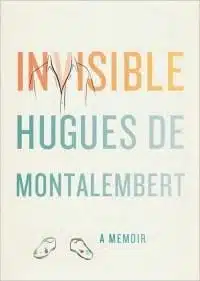
Invisible: A Memoir by Hugues De Montalembert is a strange little book. Literally.
Most memoirs tend to be longer works; most memoirists, it seems, like to write about themselves and tend to tell audiences everything. De Montalembert’s memoir is a scant 130 pages, and many pages only contain a couple dozen words.
The narrative technique is also unique. The book’s average paragraph length is probably about 15 words, and the book uses both blue and black type. At times, the narrative style is almost jarring — short sentences, short paragraphs, vague pronoun references, no quotation marks — all contribute to a slightly jolting experience. For example:
In the middle I stopped and they said, Why did you stop?
— Because there is an obstacle in front of me.
— Yes, what is it?
— I don’t know; usually there is no obstacle there.
At other times, the book is written much more traditionally and often with beauty, style, and grace. De Montalembert describes going on a walk at 3AM::
The night is warm; it touches my face, my hands. I stand still for a while, my long fiberglass cane held in front of me like fencing foil ready for a duel with darkness. Immobile, I create a vacuum inside myself; become a nocturnal animal blending into the night. Sounds of emptiness echo from the neighboring garage, drawing me in.
Some may find the juxtaposition between these two narrative styles too jarring to be enjoyable. To be honest, for the first few pages, the narrative style irritated me a little, but then I found my reading rhythm and the seemingly opposite narrative techniques began to fit together.
The narrative style is so unique it almost upstages the plot of the memoir, but there is an interesting story and message in this book. The book begins in 1978 and tells the story of De Montalembert, an artist and photographer, who is blinded when he walks in on two men robbing his home. The robbers throw paint remover into his eyes, and De Montalembert relates:
Paint remover. It’s not an acid, it’s a base. If you wash a base with water it doesn’t go away. It continues to dig. While I was fighting with the big one, the little one threw that paint remover in my face. I understood that something quite serious had happened.
(Keep in mind that in the book each one of these sentences is a different paragraph.)
Readers follow De Montalembert through the attack, his physical recovery in the hospital, and his mental and emotional journey as he tries to regain his independence and to avoid falling into the pit he claims society tosses the blind into. The book jacket states “part philosophy, part autobiography, part inspiration, Invisible will change the way readers understand reality and look at the world”. I would argue the book is part philosophy, part inspiration, with a smattering of autobiography thrown in.
Advice, words of wisdom, and sage observations seem to form the most important part of this book. Early in the book De Montalembert tells the audience:
If you love somebody and you cannot look into the eyes of the person, something is missing. All the rest, her beauty, the shape of her body, you see everything, but — the expression in her eyes, that is something you will never be able to touch … How many time have you walked in the street or been in the subway and you just make eye contact with somebody and something happens? And maybe it will even change your life.
This passage is only loosely connected to De Montalembert’s life and the inference that the sighted need to be reminded about the importance of eye contact is clear.
The book may be written in a unique narrative style and is more self-help/philosophy than memoir, but for the most part, De Montalembert’s thoughts make sense. After noting the number of people who would sit and tell him everything, De Montalembert explains:
… in the Catholic church they have those little boxes where you make your confession and it is very dark and you can’t see the priest and you hope he can’t see you. And so you feel free to confess your sins. For the same reason, many couples talk in the car because they don’t have to make eye contact.
Not all of De Montalembert’s musings are so concrete, however. Much like the writings of Annie Dillard, this narrative occasionally has an intangible quality, and some of De Montalembert’s thoughts are definitely open to interpretation. He relates, for example, “To see, one should liberate oneself from the immediate. Looking beyond opens the world to where beauty has become one with truth. The harmony of the invisible is always more beautiful than the one of the visible”.
Invisible might not quite be as life altering a read as the book jacket suggests, but thoughts such as these give readers a lot to ponder. The tone is honest, and even though a great deal of advice is given, De Montalembert never sounds preachy or pompous nor does the book ever feel didactic — even though I did learn something. It just wasn’t about De Montalembert. This book really seems to be more about the audience than the author, and I didn’t walk away from the book thinking how much I knew about De Montalembert — I walked away thinking I knew a little bit more about myself and the world around me.
